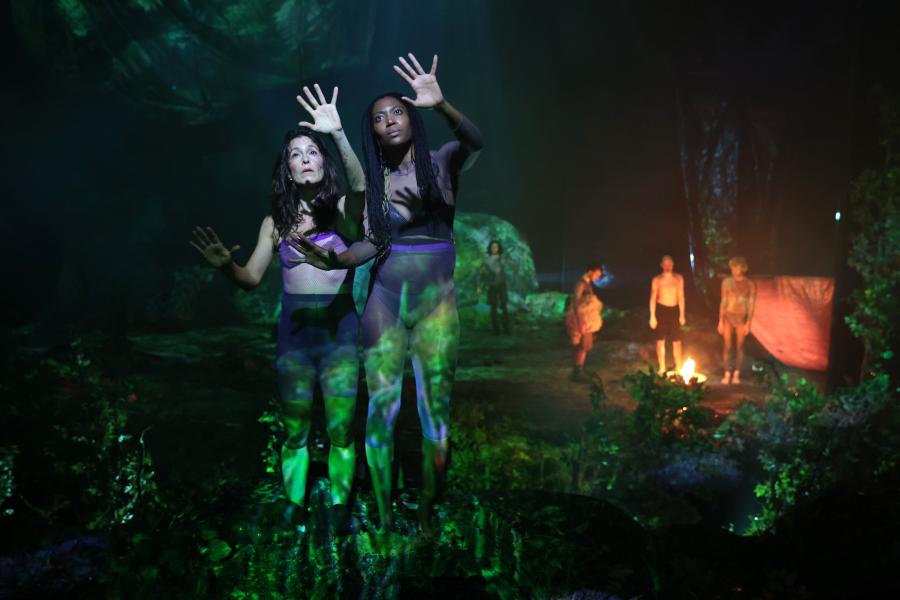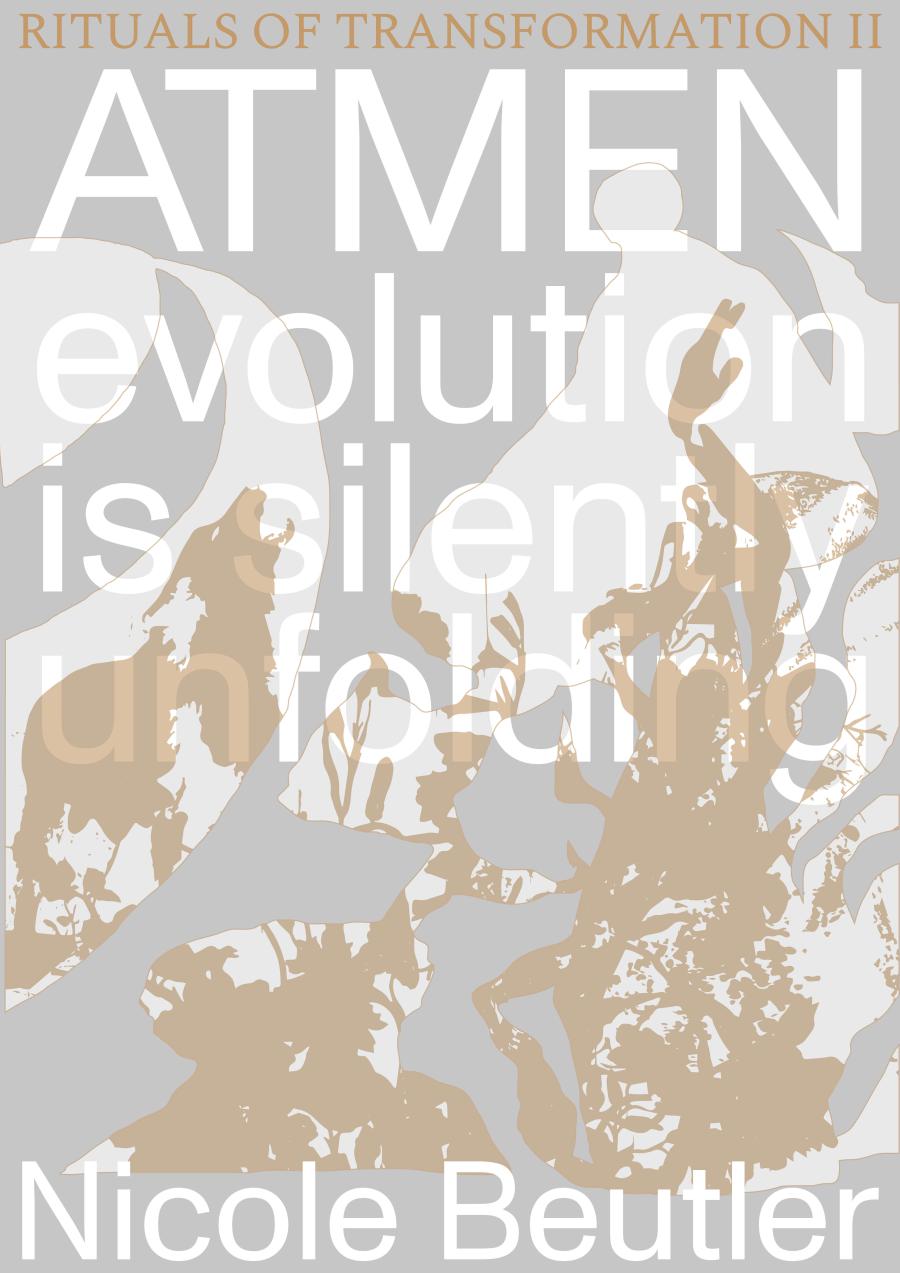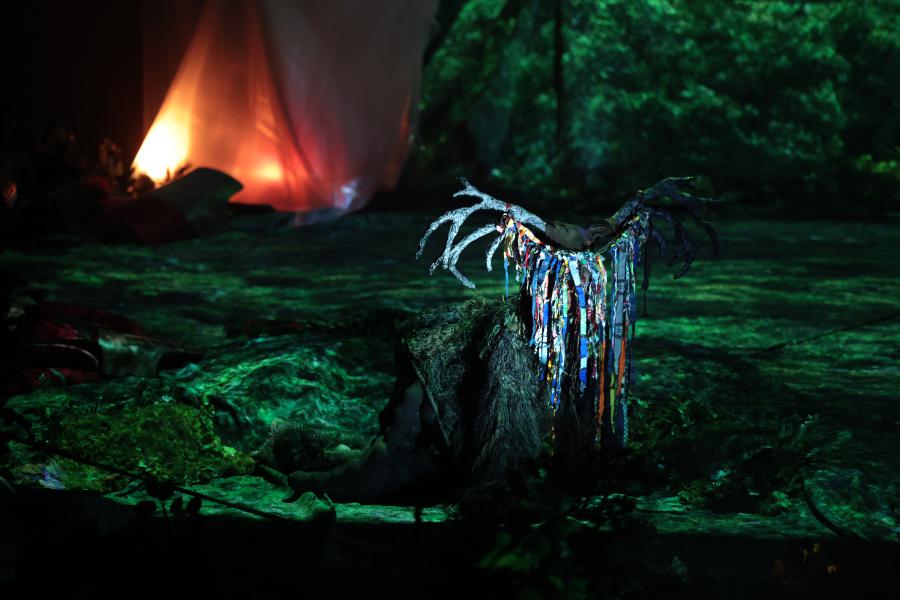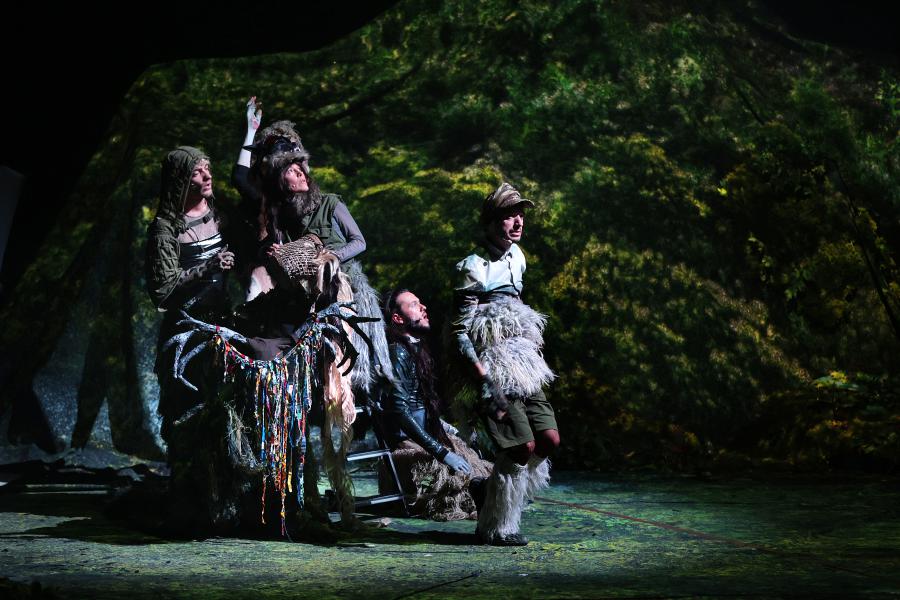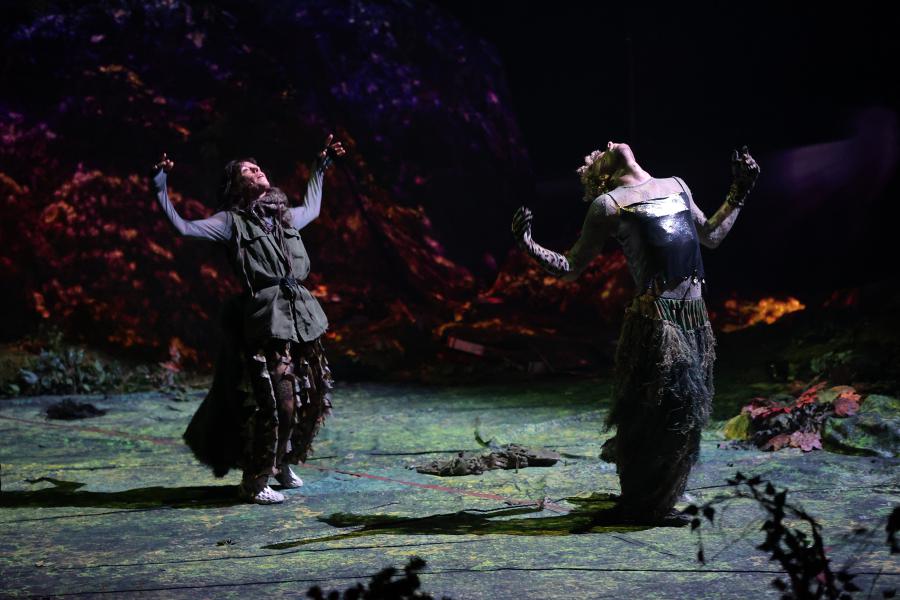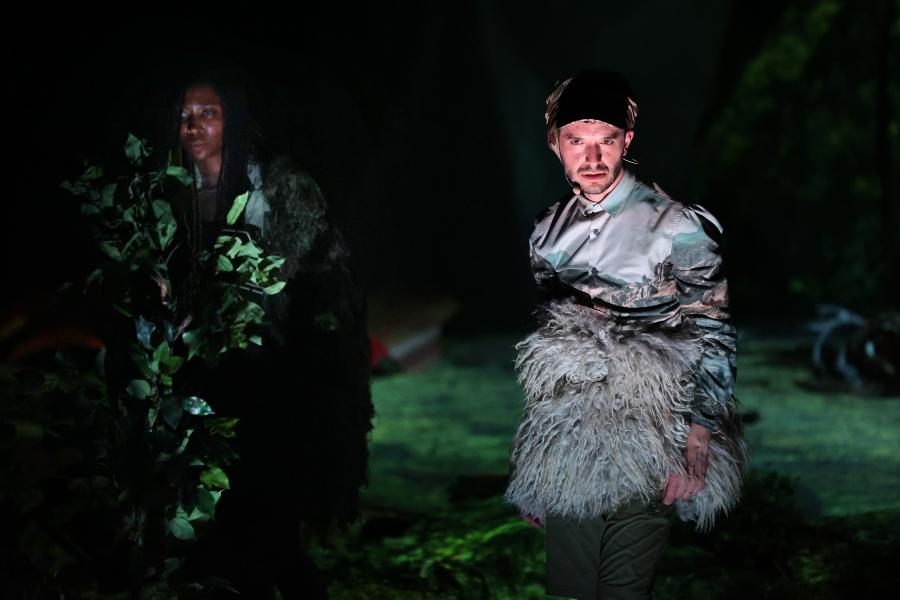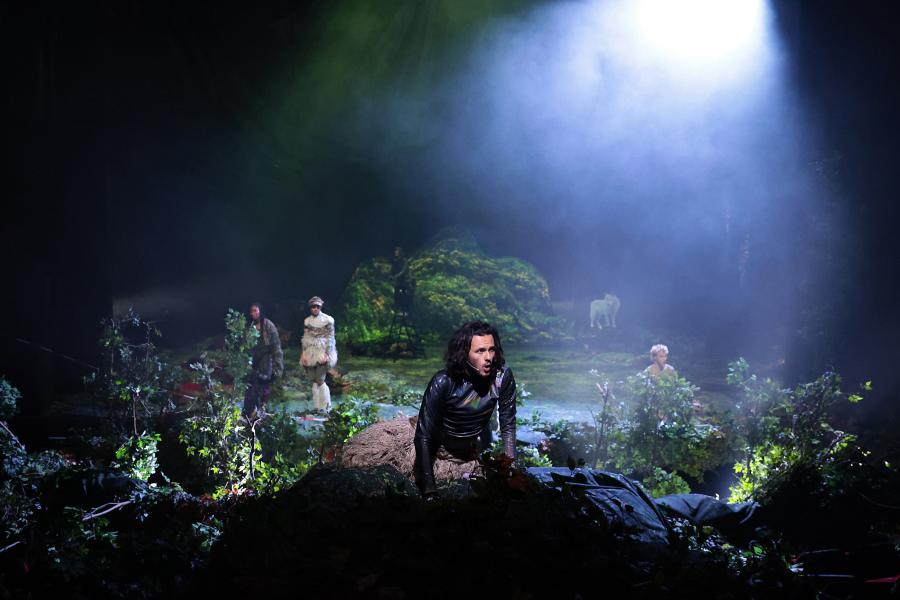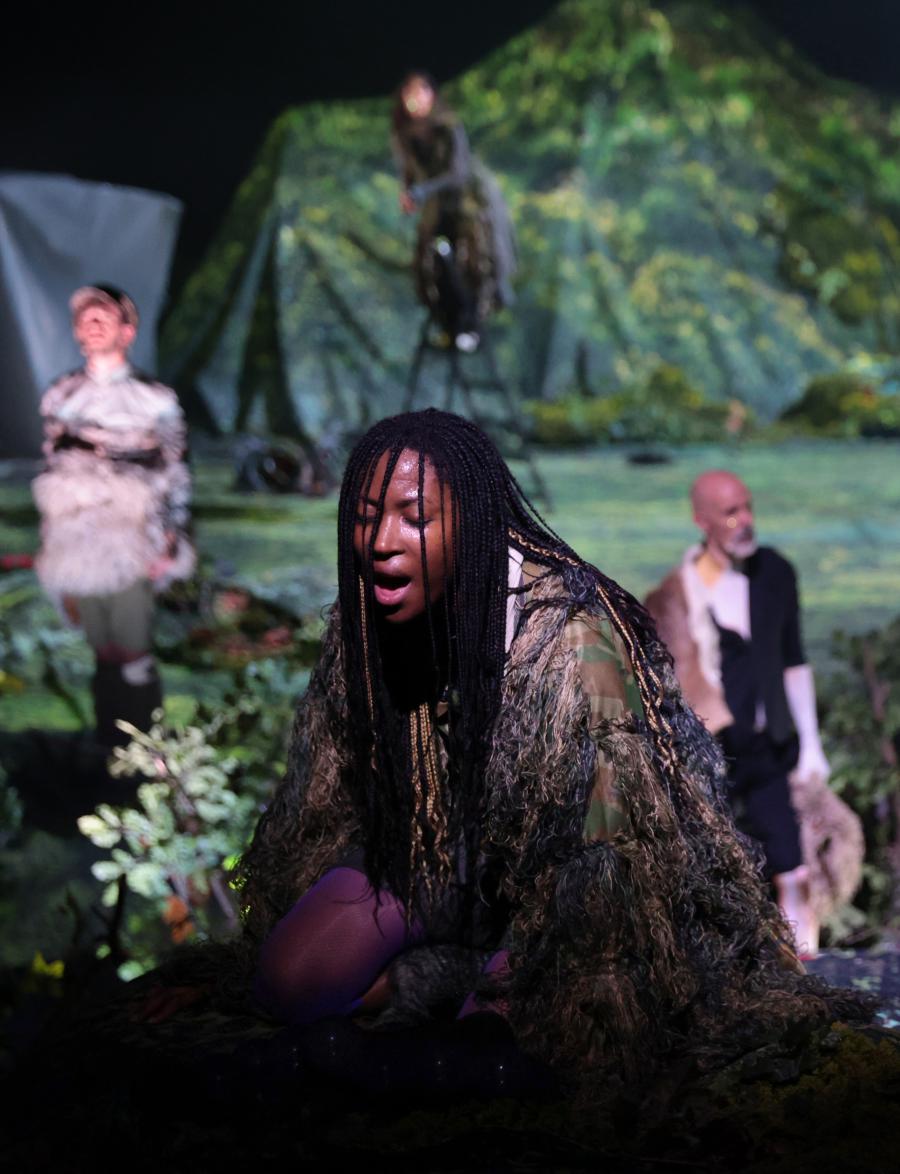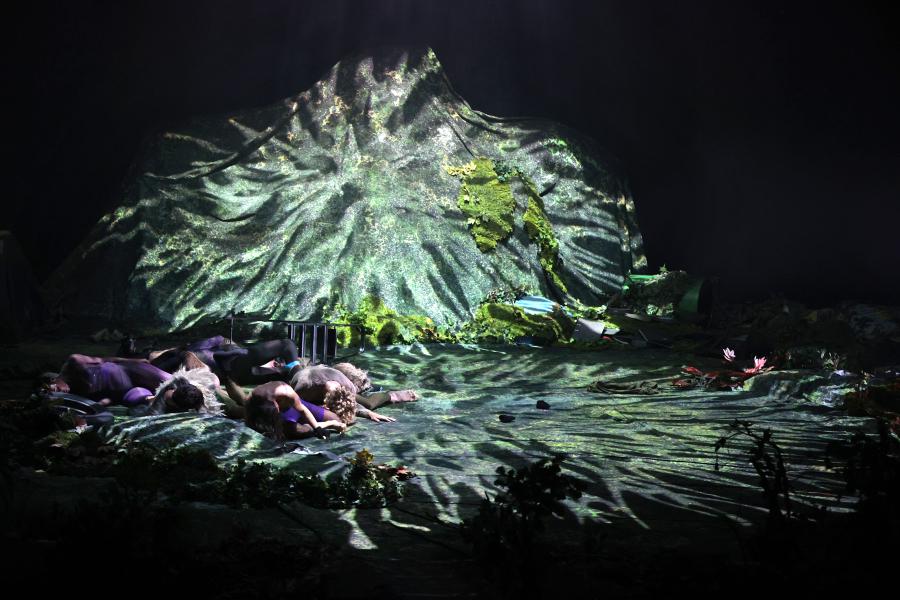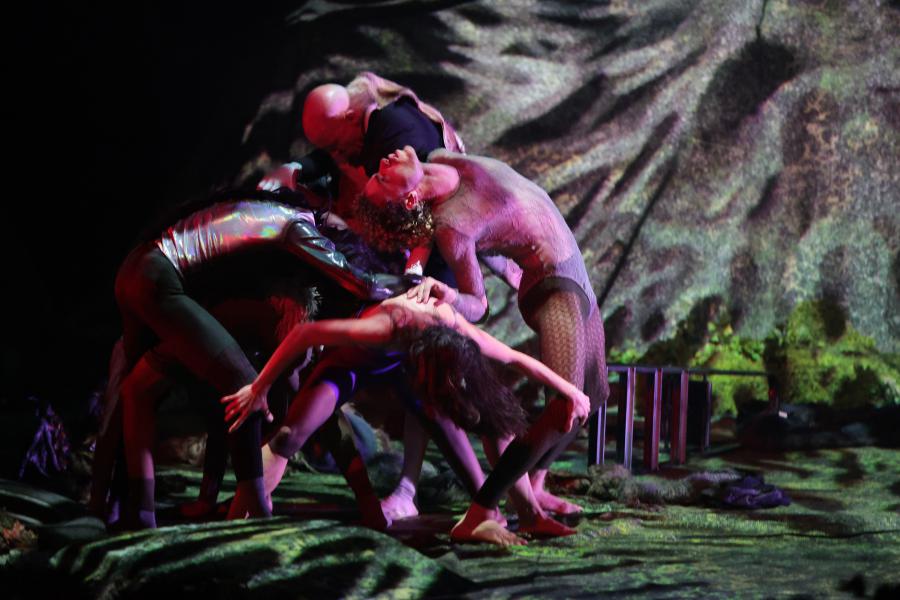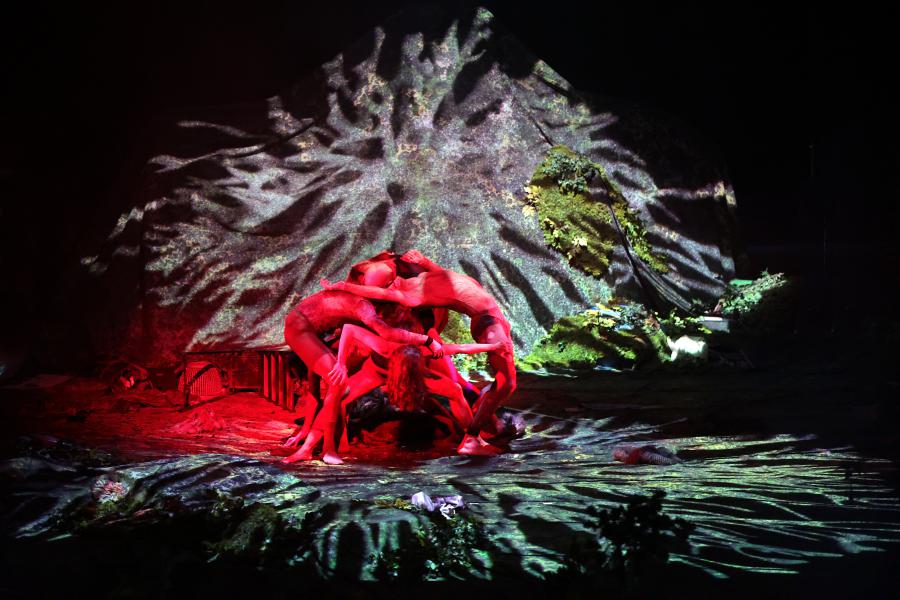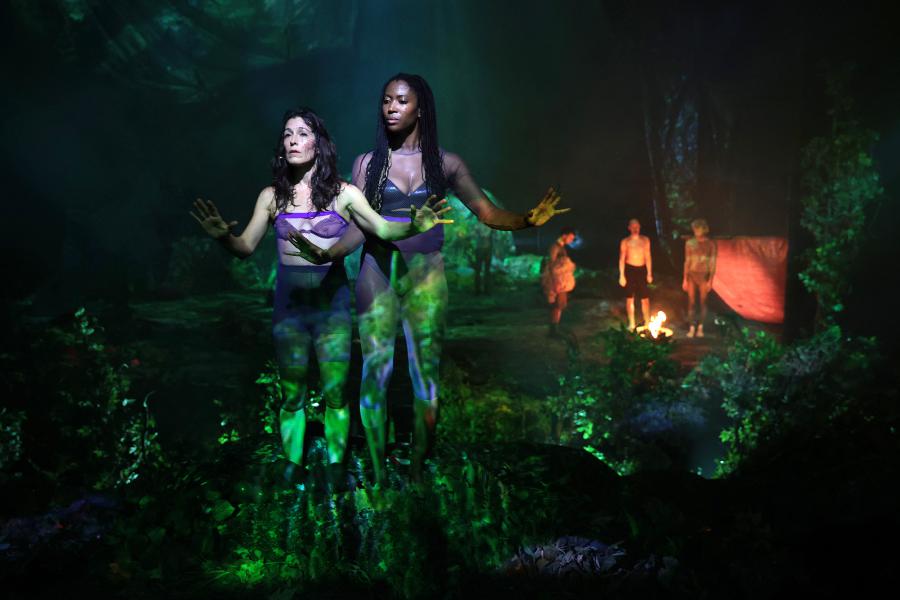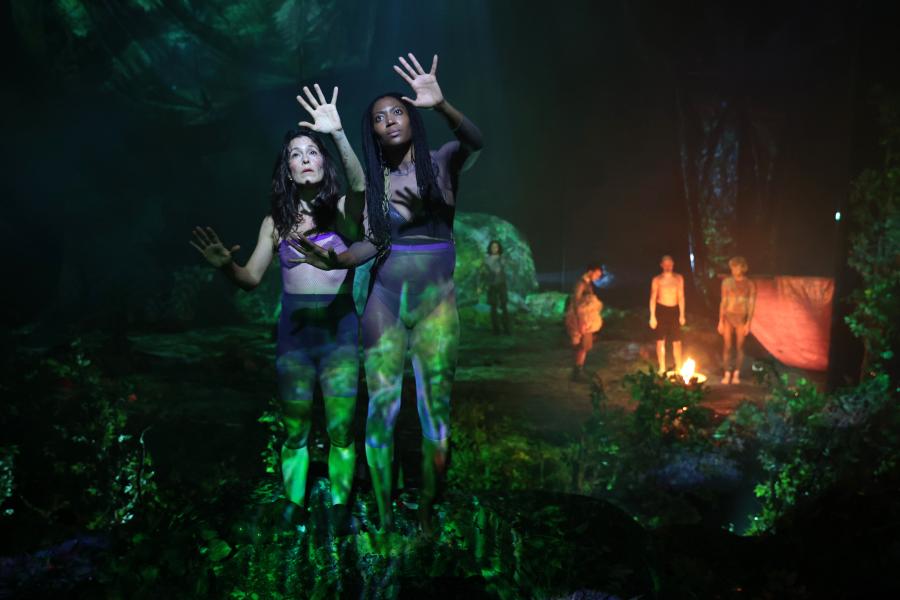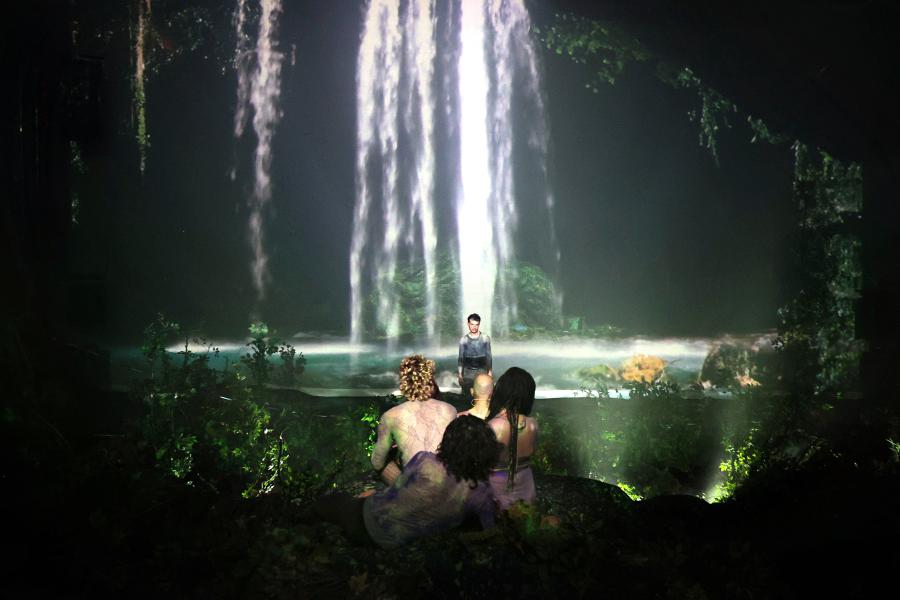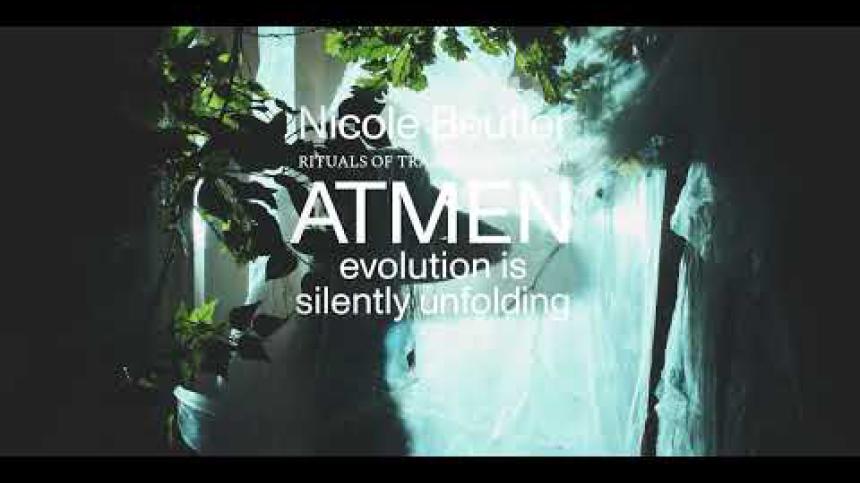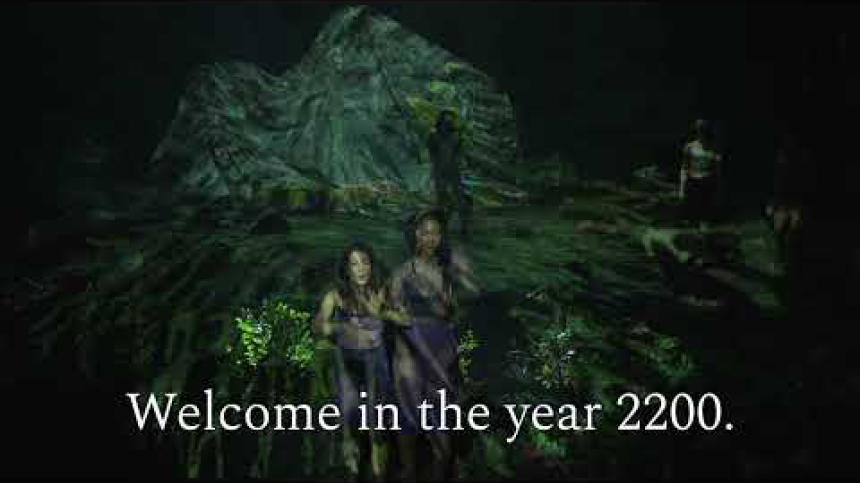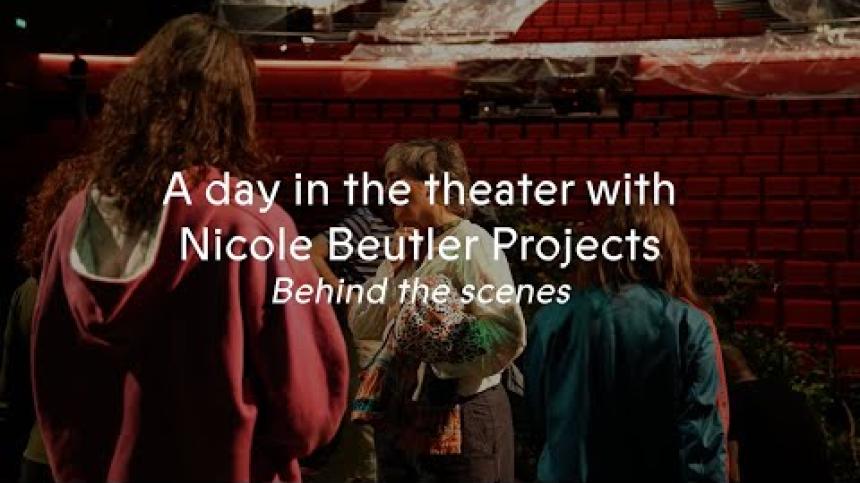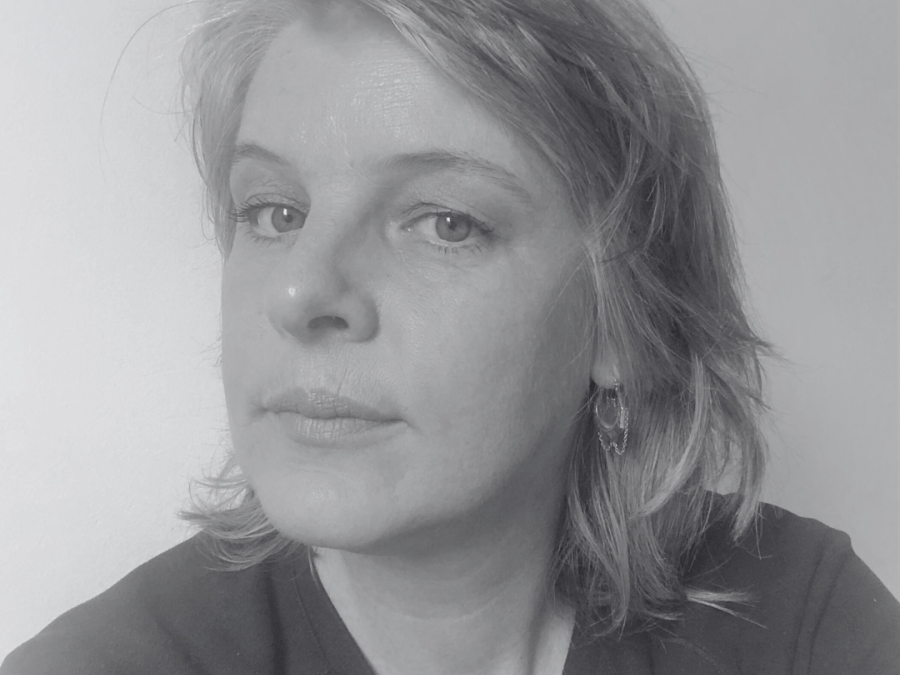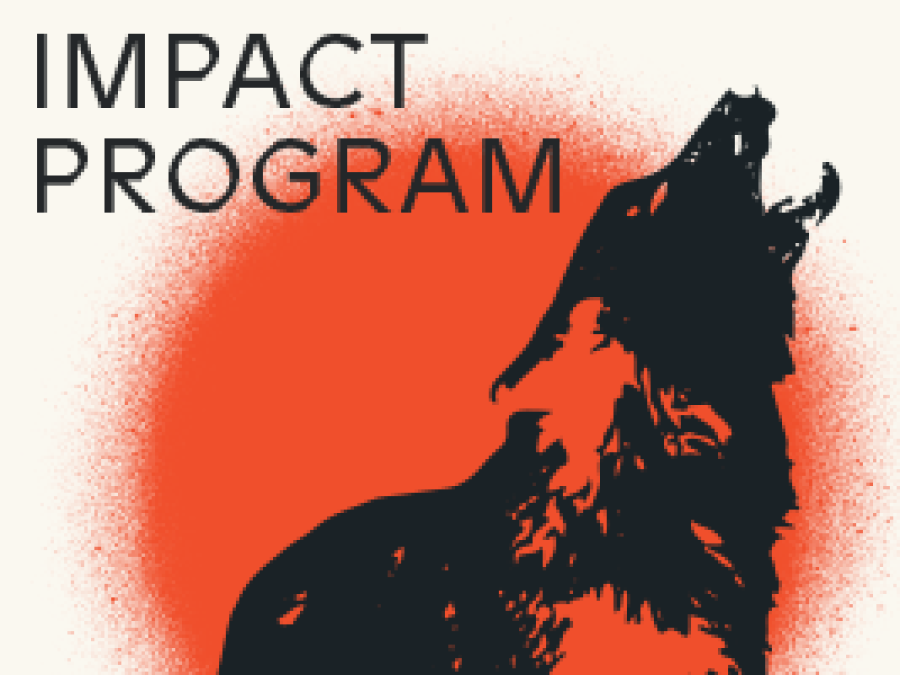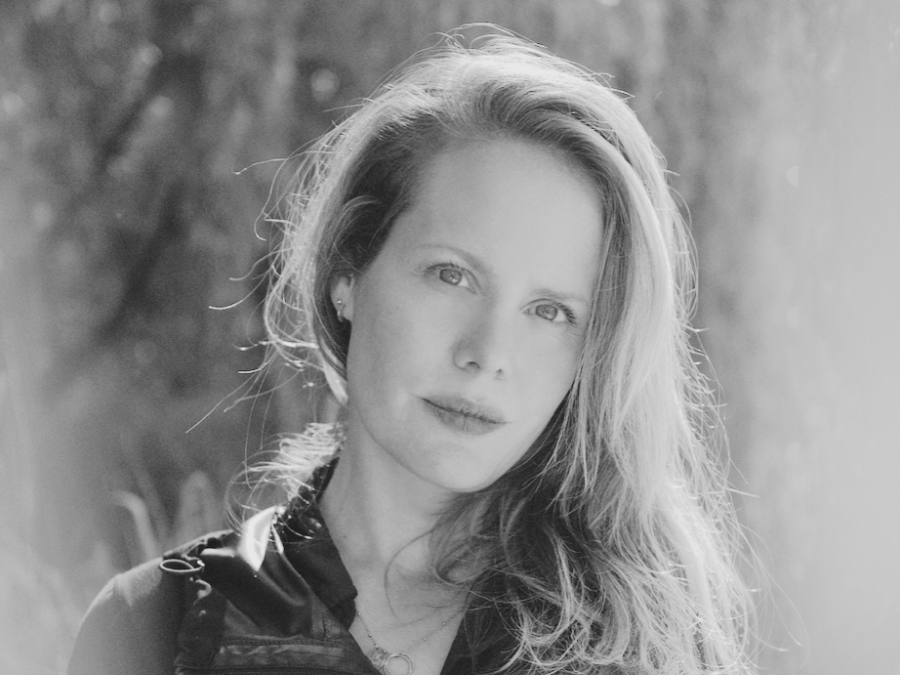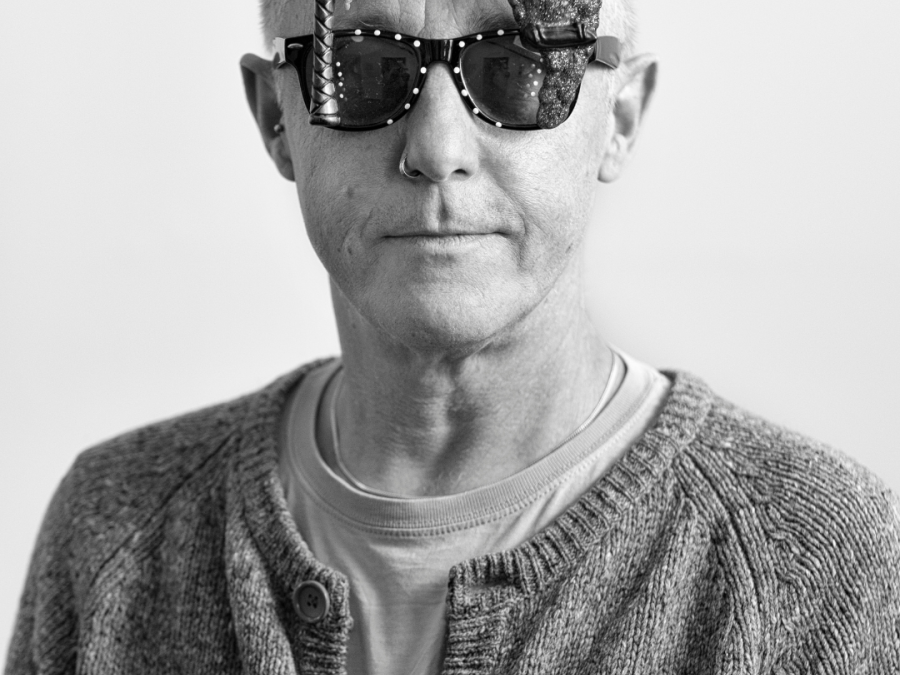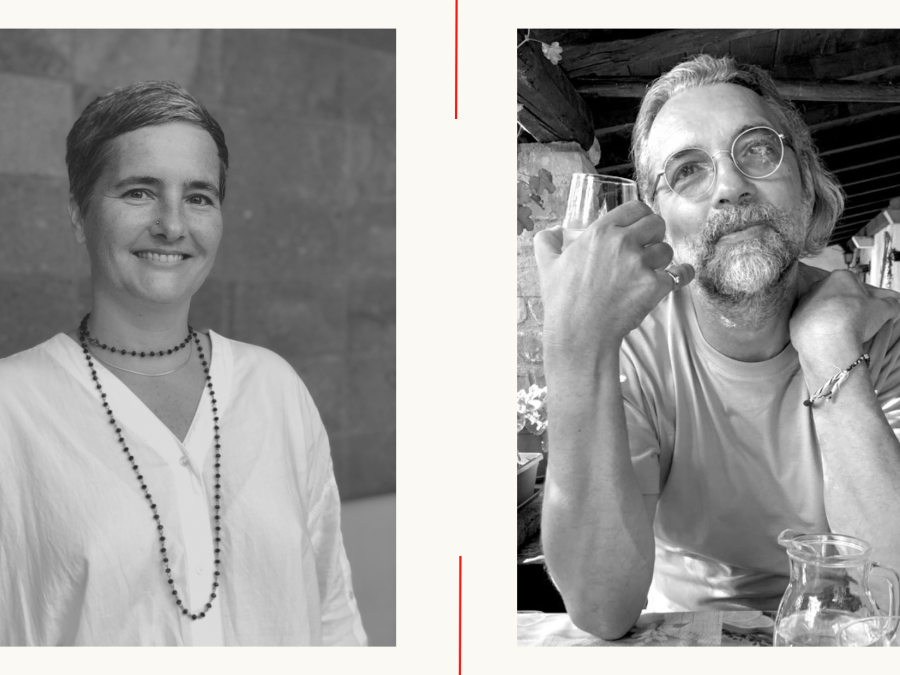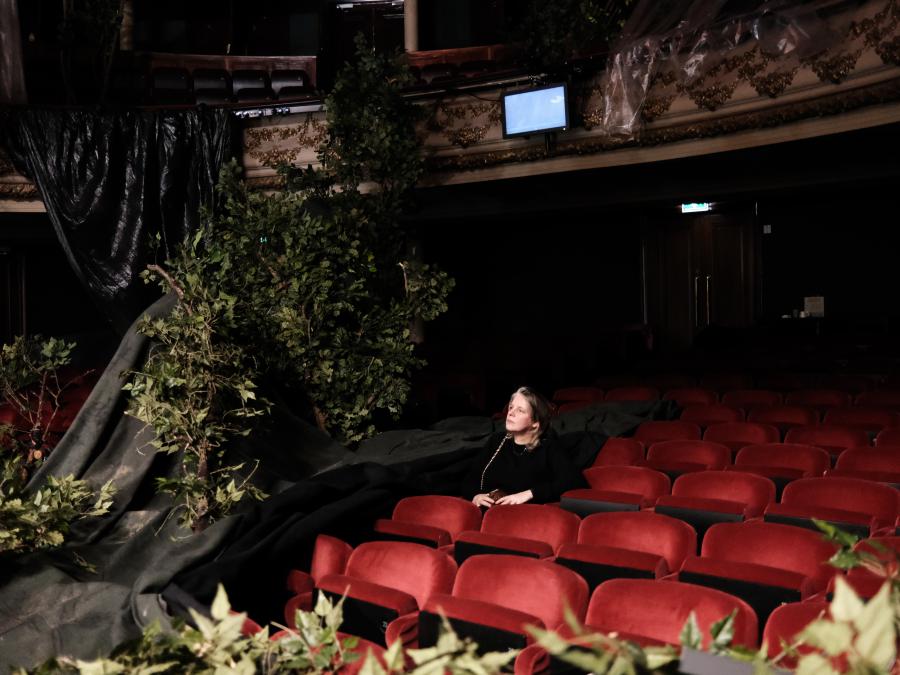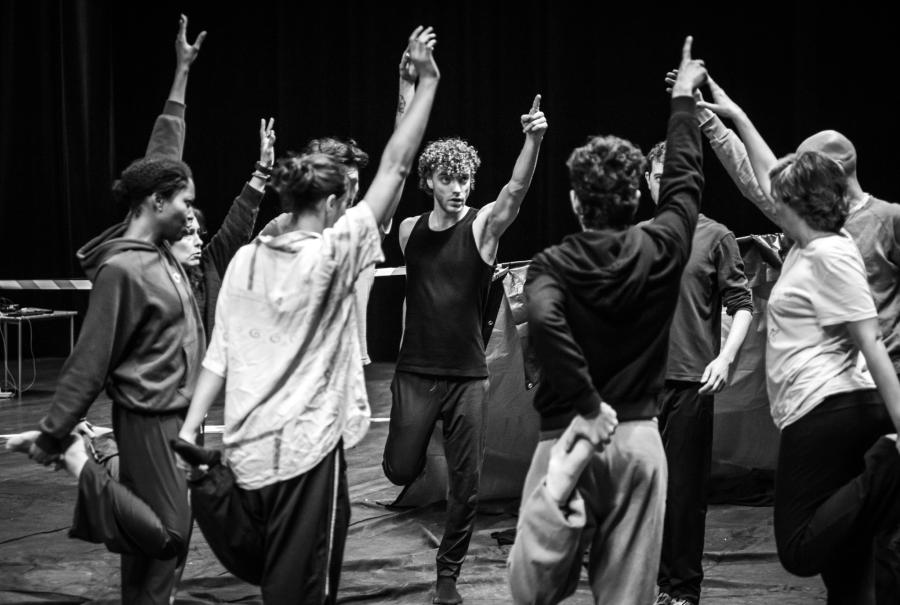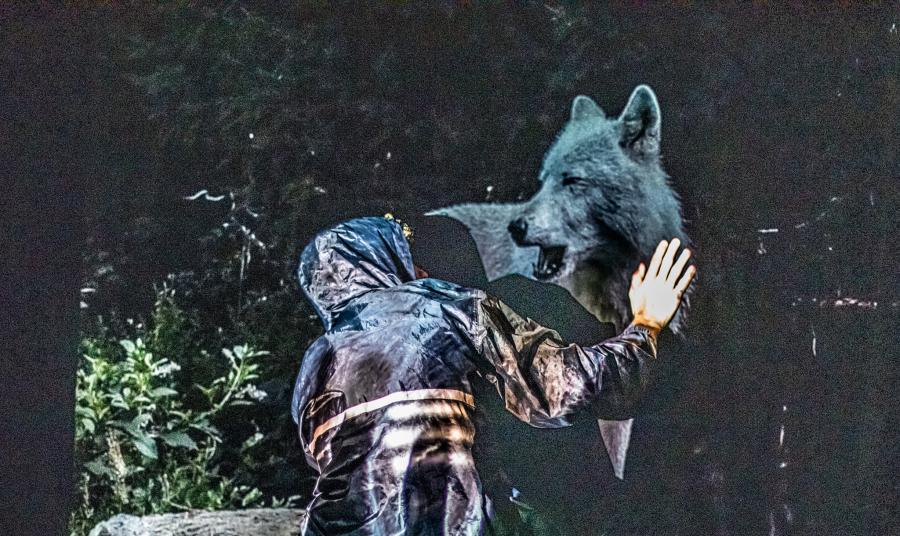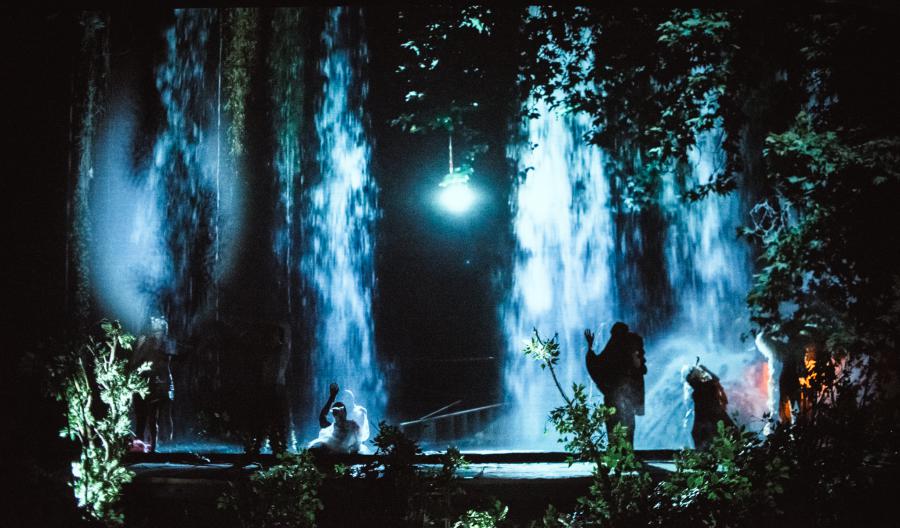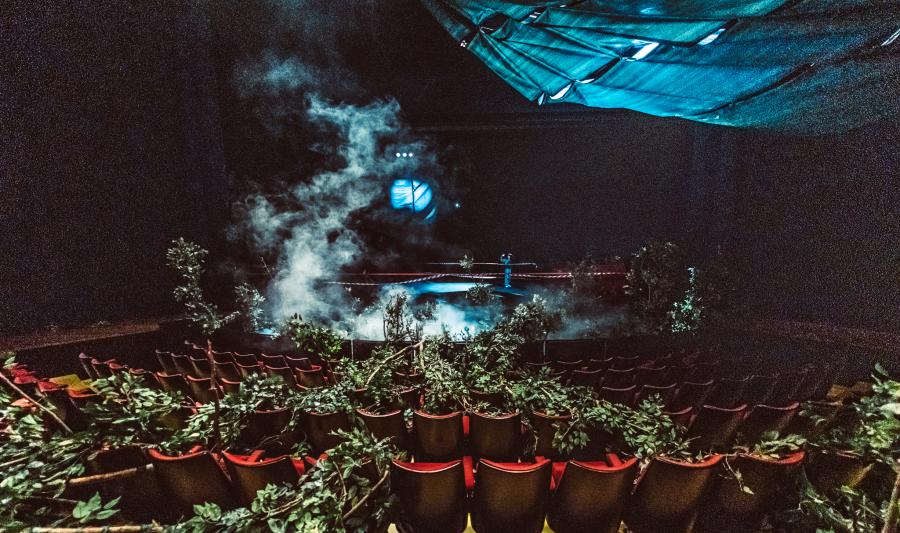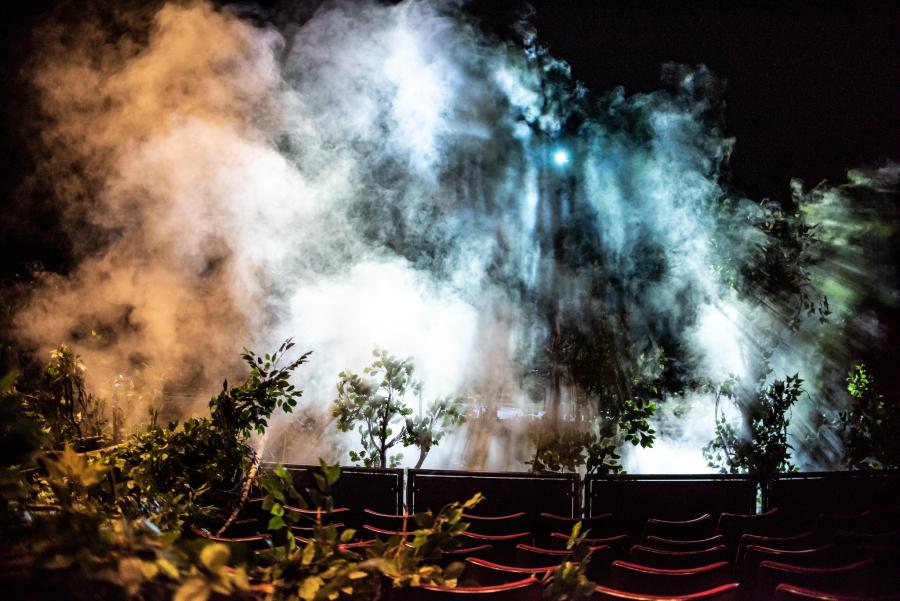ATMEN
In ATMEN / evolution is silently unfolding Nicole Beutler and her team welcome you into a possible future, the year 2200. Beneath the collapsed burden of the self-defeating hunger for power of the humans, the planet is finally breathing again and the surviving humans appear from the shadows in search of a new community.
Overgrown by nature the theater hall is now a ruin wherein flora, fauna, bacteria and luminescent fungi thrive. The red plush of the theatre chairs has become part of this living ecosystem. Under the moonlight, a wolf howls and six human/hybrids move from the shadows, dancers and singers. As part of the breathing biotope they are entangled with long forgotten radio waves, rustling leaves and electronic music compositions by our house composer Gary Shepherd, intersected with remnants of songs by romantic composer Franz Schubert. Visual artist Heleen Blanken develops three-dimensional projections overgrowing the theater with a nature that is resilient. Deep in these damp, vibrating, cavernous depths, at the bottom of a post-apocalyptic reality, the wild promise of an unimaginable future gradually takes shape. The audience is invited to become part of this ecosystem for some time.
Premiere: 18+19 October 2023 Internationaal Theater Amsterdam (ITA)
Tour of Dutch theatres: January - June 2024 (see calendar)
Presented and supported by the arts & culture programme of the Amsterdam Dance Event (ADE) and by Internationaal Theatre Amsterdam (ITA).
Listen to the introduction:
RITUALS OF TRANSFORMATION II
ATMEN / evolution is silently unfolding is the second part of the trilogy RITUALS OF TRANSFORMATION. GINKGO or: 56 million years ago there were palm trees on the North Pole, was a farewell to the world as it is made by humans. In ATMEN / evolution is silently unfolding, Beutler and her team let nature catch its breath back and invite the audience into a future biotope where humans dwell in the shadows. The third part of the trilogy, NOW WE ARE EARTH / An Orchestra (April 2025, Opera Ballet Vlaanderen) attempts a new balance between humans, earth, animals, fungi and technology. With this trilogy Beutler wants to touch the audience by offering new perspectives, by looking beyond doom scenarios for the future of humanity in search of new, unexpected connections, a paradigm shift generating potential for hope and with that pathways for change.
IMPACT PROGRAM
Together with various theaters in the Netherlands, we present an impact program featuring lectures, discussions, and encounters where we delve deeper into our relationship and position with the planet. We also explore the possibility of looking at the distant future from a more-than-human perspective together.
Read more about our impact program here.
Please note that the program, design, and timing may vary depending on the theater. Keep an eye on the theater's website for activities and timing of the impact program in your city.
REVIEWS
-
Nicole Beutler only wants to create performances about the climate crisis anymore.
The performance "Atmen" takes place in a theater overtaken by nature. Theater maker Nicole Beutler takes her audience on a journey to a possible future, where our planet slowly catches its breath after a climate disaster.
Fritz de Jong October 18, 2023, 03:00
In 2021, Nicole Beutler (Munich, 1969) announced that she would exclusively create performances about the climate crisis for four years. However, that did not fully succeed: she also made an acclaimed performance in between that revolved around Arnon Grunberg's dance shame. Nevertheless, this did not compromise the planning of her trilogy "Rituals of Transformation (Towards a New Humanity)". The choreographer had actually taken a step towards this environmental cycle in 2019 with "Our House Is On Fire". "That famous statement by Greta Thunberg felt so urgent. My daughter, who was fifteen at the time, said: I still want to be a mother and grandmother someday. Then I realized: that's in 30 or 60 years, what will the world look like then? In that performance, I wanted to be activist and only say that, in different ways: our house is on fire."
In the first part of the triptych, the dance opera "Ginkgo or: 56 million years ago there were palm trees on the North Pole" (2022), the fire has already extinguished. "In that performance, we bid farewell to humanity. The performers try to lead a normal life on a huge pile of stuff, a kind of garbage dump. When they realize it's too late to save anything, they make a kind of altar of all those objects, and that becomes a mountain into which they disappear. The piece ends with a beautiful scene: a world without people."
With "Atmen," the second performance of the trilogy, Beutler depicts a world thereafter. "In the year 2200, the theater has been taken over by nature. I try to paint a picture of a landscape, of a state where humans emerge from the shadows. With adapted behavior, more attentive to the environment. A new human who does not return to nature, but moves forward to nature."
Read more here.
-
Overgrown Parktheater bathed in a silver glow.
EINDHOVEN - The Philipszaal of the Parktheater has been transformed into a forest in the performance 'ATMEN'. It will be shown three times in Eindhoven during the Nieuwe Maan festival. A vision of a world after the collapse of current civilization.
"What would happen if we suddenly weren't here anymore," says Nicole Beutler, choreographer and theater maker about the performance Atmen. It is the second part of a triology titled Rituals of Transformation. Animals, plants, fungi, and microorganisms have taken over the earth from humans. The planet can finally breathe again.
"In essence, the performance offers a positive vision of the future, in which the earth recovers," Beutler continues. "One of the sources for Atmen is the book The World Without Us by Alan Weisman. It's a thought experiment. It's not likely to happen, but it does open up a horizon."
Metal refinement
Beutler came up with the idea for this triology because her daughter told her five years ago that she wanted to become a grandmother. "That's at least sixty years away. I started to wonder what the world would look like then. If you follow the news with all those doomsday scenarios, you become overwhelmed by helplessness. With the possibilities I have, I wanted to focus on that theme, but to think beyond the fear. It's a future vision in three phases, based on the process that alchemy works with, a refinement of metals into gold in three steps."
The first part, GINKGO, represented the black phase, the end of the world due to overproduction, causing humans to drown in their own waste. The material used in this performance was largely found on the streets by Beutler's company. The second phase, ATMEN, is mercury. "It's a moonlit night. Everything is bathed in a silver glow, everything is fluid and in motion. The theater has been taken over by nature. People emerge from the shadows. They form a new community that adapts to this reality and becomes part of the environment."
Networks of fungi
Beutler creates this environment with set pieces on stage and in the auditorium, and a projection by video artist Heleen Blanken, who works at the intersection of nature and technology. In it, organic forms move, and you see the growth of root systems and networks of fungi and mycelium. The atmosphere in the auditorium is enhanced by music. In addition to a live performance of Franz Schubert's song Das Gesang der Geister über dem Wasser, there is an electronic composition by Gary Shepherd. Because the set extends into the auditorium, the audience is physically part of this vision.
I want to think beyond the fear in this vision of the future
Nicole Beutler, Theater maker
Beutler experimented with the stage design at the opera in Antwerp. The auditorium had to look like it had been empty for a century and a half. "That was based on a visit to the Bialowiezabos in the far east of Poland, the last European primeval forest. There you learn how trees that we declare dead still have forty years of life left, until they gradually fall, decay, and are transformed by bugs. After Antwerp, we worked for a week at the Parktheater. There we looked at how the performers can move in the set. Where do people hang out? Are there places where they can make fire?"
Overgrown
The audience enters an overgrown space. In the darkness, the environment slowly reveals itself. "That experience of time, in which the audience is immersed, is central. It's a journey through time, in which they detach from the here and now. I don't impose any rules on them. It's essential to realize that we are part of this whole. I want to use the theater as one of the last places where we can reflect as a group on important topics, such as the future of humanity."
'Atmen' by Nicole Beutler Projects. Parktheater Eindhoven. Sat January 13, 9:30 PM. Sun January 14, 4:00 PM and 7:00 PM. Info: nicolebeutlerprojects.nl/voorstelling/atmen
-
Nicole Beutler Projects’ ATMEN at Koninklijke Schouwburg in The Hague
It can sometime be difficult to accept that the Earth is warming while we are in the middle of the current cold snap with snow on the roofs and ice on the canals. But global warming is, we are lead to believe, and unless we do something about it, leading the planet to destruction. The end is nigh – but then it always has been.
The Nicole Beutler Projects’ raison d’être is the problem of climate change. With Atmen Ms Beutler has reached the middle of her trilogy Rituals of Transformation, the first part of which, Gingko, dealt with the dying planet. Set, post-apocalypse, amid the detritus of a broken world, it foretold of our demise and even threatened the gingko tree which has survived on earth for 290 million years.
But it’s not all doom and gloom. Atmen imagines the aftermath of climate change, that Earth will eventually breathe again and that humankind will emerge from a world engulfed in greenery, the same primeval soup that first nurtured life.
For the performance the theatre itself becomes this environment with the orchestra pit filled with trees and plants and foliage encroaching half-way into the auditorium. The stage itself is dominated by a huge grey mound (earth/rock/lava?) and from beneath it the stirrings of life can be detected as six characters gradually emerge from the dark undergrowth. A discarded oil drum, a reminder of les temps perdus, can be seen half-hidden at the back and a rather incongruous metal stepladder plays a prominent part in the proceedings. In Gingko the animal kingdom was represented by a polar bear, in Atmen it is a white wolf that makes an appearance.
The movement of the performers was often like some long forgotten tribal ritual that worshiped the Earth as a god. At other times the choreography was primitive, depicting a struggle for survival in an environment that although green, was still hostile. There was respite at the end when things settled down, marked by some fine choral singing from the ensemble.
Visually and theatrically Atmen was spectacular. In addition to the abundance of real plants in the theatre there were some enormous projections designed by Heleen Blanken, which augmented the amount of vegetation around us. The most spectacular of the projections was beyond doubt a huge waterfall, the full height of the stage. The sound design by Ruben Kieftenbelt, including electronic music by Gary Shepherd, added an extra dimension to the show as did the often breath-taking lighting effects. Atmen, as indeed was Gingko, is total theatre, immersive and engulfing and is beyond doubt a tour de force to be reckoned with.
However, most plants benefit from a little pruning and consequently grow bigger and stronger as a result. The same could be said of Atmen where there were passages during which not much seemed to be happening or the action was repetitious or too drawn out. Nevertheless, Nicole Beutler’s Rituals of Transformation trilogy undoubtedly has its heart in the right place and I shall certainly be looking forward to the final part, Now We Are On Earth next year. Michael Hasted 20th January 2024
You can listen to the ArtsTalk Radio interview with Nicole Beutler here
Nicole Beutler Projects’ Atmen will be on tour throughout The Netherlands and Germany until 15th June.
-
PLANTS, MOSS, AND FUNGI TAKE OVER THE THEATER HALL
In ATMEN, the middle part of the Rituals of Transformation trilogy, Nicole Beutler leads her audience into a theater hall overgrown with plants, moss, and fungi. The image of a cultural venue overtaken by nature is breathtaking.
In Nicole Beutler's award-winning production 8: Metamorphosis, performers and audience found themselves on the theater stage. Towards the end, viewers were rewarded with a memorable sight: the screen between stage and hall rose, revealing a theater bathed in mist, where a tree had sprouted among the empty seats.
This image, of nature reclaiming a human-built space, is further developed in ATMEN. Instead of just one tree, now half of ITA's Great Hall is overrun. The stage is covered with a carpet of plants, and an overgrown pile of garbage serves as a sort of catwalk extending into the hall, where multiple red plush chairs are hidden under green organisms. The audience is guided into the hall in darkness, emerging from similarly darkened theater corridors.
ATMEN not only connects to 8: Metamorphosis. The performance is the second in Nicole Beutler's ecologically activist trilogy Rituals of Transformation (towards a new humanity). In the first part, GINKGO or: 56 million years ago there were palm trees on the North Pole (2022), we saw humanity meet its end on a self-created garbage dump. ATMEN is set in the year 2200, after this ecological disaster has occurred.
In Beutler's vision of the future, the planet slowly begins to breathe again. The handful of people who survived the disaster have forgotten language. Instead, the six human figures that slowly emerge from the green background make clicking tongue sounds. The six develop other forms of communication, not through speech but through movement. It's not a crazy assumption that dance can play a role in group formation, and that's reflected here in a tribal-like choreography. And then it turns out that in the collective memory of these human survivors, there is also a remarkably clear memory of classical singing.
Relatively quickly, we see the group of human survivors re-evolve from crawling creatures covered in green plant husks to clothed people peacefully gathering around a fire pit. That evolutionary speed feels inversely proportional to the viewer's perception of time. Thanks in part to Gary Shepherd's atmospheric soundscape, the first twenty minutes are certainly worth taking the time to settle into this green world, to absorb all the details, and to see the players emerge from the background. However, afterwards, the performance feels longer than the choreographic and dramatic material justifies. Even the cleverly integrated projections by video artist Heleen Blanken, such as a magically emerging image of a white wolf, cannot disguise the fact that the performance feels static and somewhat distant. Even when the dancers and singers come close to the audience.
In addition to the compelling opening images, ATMEN also offers a beautiful final scene. On a transparent canvas, we see a projection of flowing water. Sitting with their backs to the audience, the group watches the water and the wisps of mist rising from the foreground. This image of people relating to the overwhelming nature clearly refers to Caspar David Friedrich's famous painting "Wanderer above the Sea of Fog". To underscore its highly romantic character, the performers sing lines from a poem by Friedrich's friend and kindred spirit Johann Wolfgang von Goethe:
''The soul of man Is like water It comes from the sky And rises to the sky''
Der Gesang der Geister über den Wassern, set to music by Franz Schubert, gives the performance a last-minute emotional charge that was missing before.
By Fritz de Jong.
REACTIONS OF THE PUBLIC:
"Impressed by the scenography, music, the performers and the context programme. Beautiful! - Lotte
''What an impressive spectacle yesterday, I will never again walk into the main hall in ITA without thinking of your fantastic design 2200'' - Magne
''Congratulations on this wonderful, intense, symbiotic and urgent performance. What a trip!'' - Roosje
''How breathtaking it was yesterday! The balance between song and dance and design was fantastic. A beautiful meditative experience.'' - Marieke
''Everything about it was astonishing. Sets, costumes, soundscape, projections, movement and voice!'' - Barbara
''A spectacular cadence. At first you have to get used to it, precisely because the players are not arranged centrally but move around the edges. Breathing rhythm everywhere.'' - Marloes
''A delightful evening, the speeches, documentary, amazing decor in the Schouwburg and also in the performance area, it was grandiose! The costume designers/ thinkers were fantastic!"- Djahan
NEWS & CONTEXT
-
Interview with costume designer Jessica Helbach.
With her background in fashion design and visual arts, she thrives on the intersection of art and fashion. -
Impact program around ATMEN
LECTURE, PANEL DISCUSSION, FILMS AND CLOTHING EXCHANGE MARKET -
Interview with video artist Heleen Blanken
“A hyper realistic biotope with video art” -
Interview with in-house composer Gary Shepherd
A world without humans, how would that sound like? -
Interview with choreographer and theater maker Nicole Beutler and dramaturge Igor Dobriçic
-
An enchanted forest at the Antwerp opera house
Research ATMEN... (evolution is silently unfolding)
Cast & Credits
Nicole Beutler Idea, direction, choreography
in close collaboration with the team:
Gary Shepherd electronic music composition
Franz Schubert music
Heleen Blanken video art
Julian Maiwald & team scenography
Julian Maiwald lighting design
Jessica Helbach costume design
Igor Dobričić dramaturgy
Neal Powless inspiration (the words that come before all others)
Justa ter Haar artistic assistance
Ruben Kieftenbelt sound design
Ellen Windhorst set editing / stage painter
Hillary Blake Firestone, Reve Ter Borg, Arnout Lems, Dominic Kraemer, Felix Schellekens, Timo Tembuyser performance, choreography & vocals
Catarina Ferreira da Silva rehearsal teacher & tour manager
Konstantinos Chatzikypraios director's assistant & second cast
Salya Berraf second cast
Durante van Kuijk head of technique & video
Maurits Thiel sound technique
Amber Stallenberg lighting technique
Femke Ravensberg set- technique
Raïssa Pater production NBP
Shewska Verberne marketing NBP
With many thanks to Nicole Geertruida (outside eye), Hans-Peter Hulsscher (head of technique & video), Valentijn Berckhout (sound technique), Nicholas Hermans (lighting technique), Yonina van Geel (production), Joao Dinis Pinho (rehearsal director & tour manager)
Sophie Luca Shepherd (your future is the reason for this trilogy)
A production of Nicole Beutler Projects
Presented by International Theater Amsterdam (ITA) & Amsterdam Dance Event (ADE)
Made with support of Opera Ballet Vlaanderen / Vonk! / Fast Forward, Parktheater Eindhoven, Internationaal Theater Amsterdam
Made possible by the generous support of Fonds Podiumkunsten Den Haag, Amsterdam Fonds voor de Kunst, Fast Forward, Stichting DOEN, AMMODO Fonds

